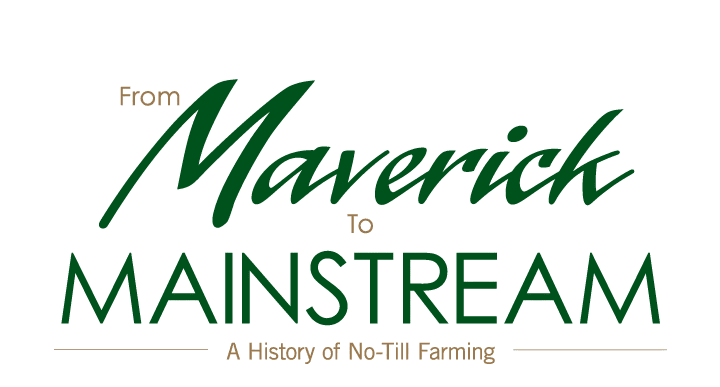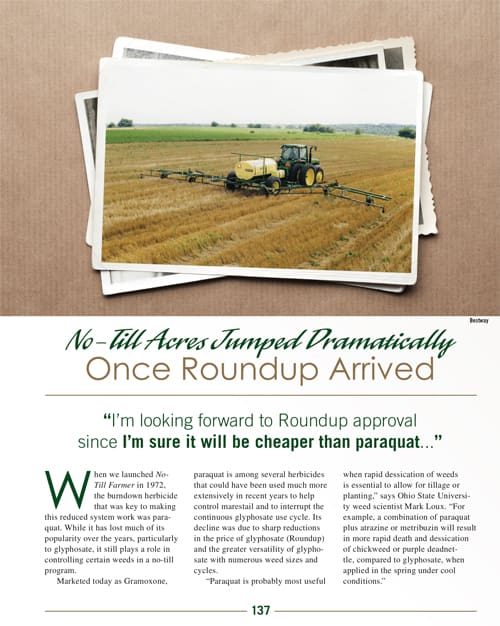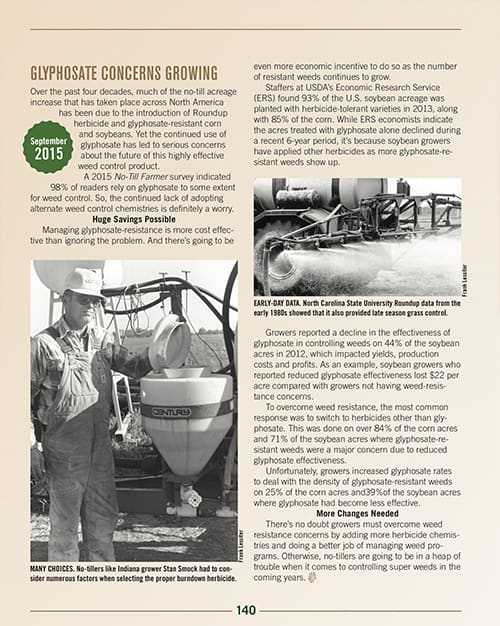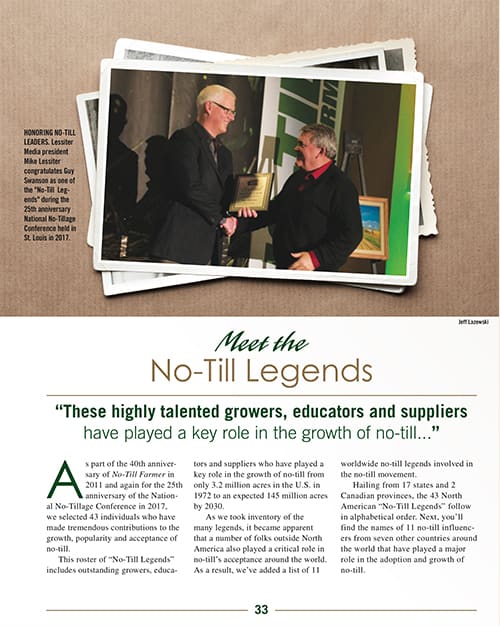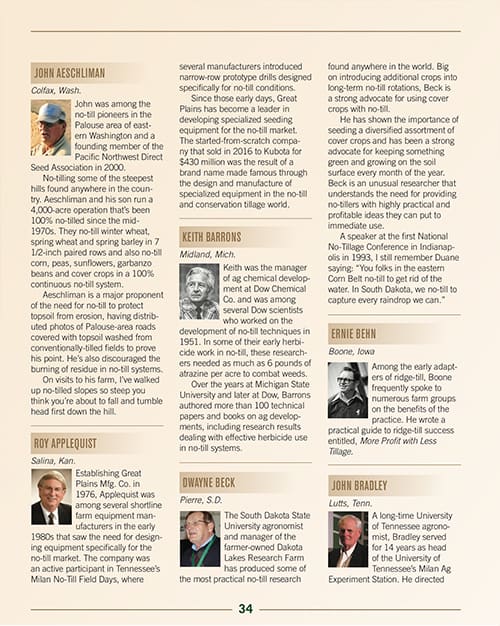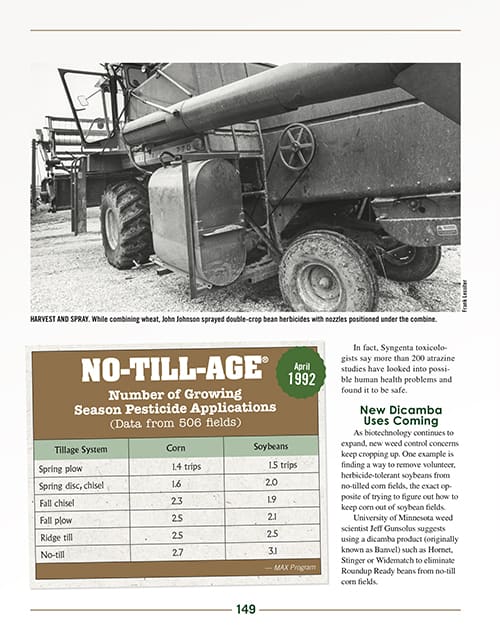
With its in-depth coverage and photographic appeal, From Maverick to Mainstream: A History of No-Till Farming features:



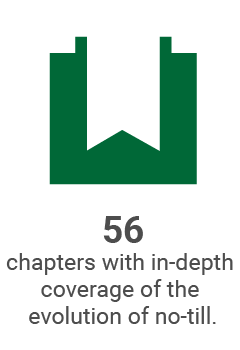
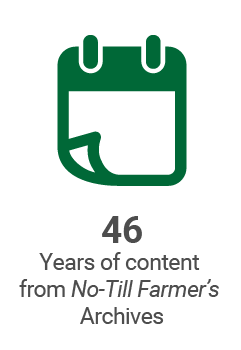

From Maverick to Mainstream: A History of No-Till Farming is the next best thing to being front and center during the beginning of the once controversial practice of no-till. The perfect gift for any no-tiller, it celebrates the innovators and leaders who changed the world. This extraordinary hardbound book takes a decade-by-decade look at the world of no-till as seen through the eyes of those who observed the many changes in no-till since the first commercial U.S. plot in 1962.
Preview the first 21 pages...



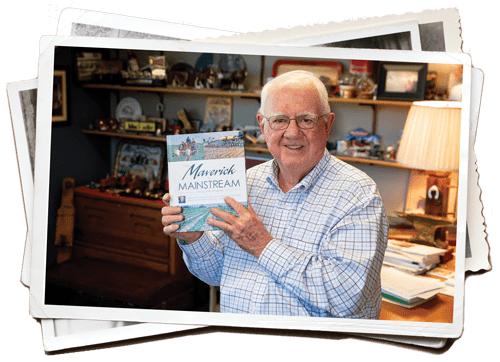
Frank Lessiter is the chairman and editorial director of Lessiter Media, Inc., an agricultural based media company he and his wife Pam founded in Brookfield, Wis., in 1981. Lessiter’s Media properties include Farm Equipment, Ag Equipment Intelligence, Farm Catalog, Precision Farming Dealer, Rural Lifestyle Dealer, and No-Till Farmer/Conservation Tillage Guide, as well as other ag digital publications, websites and events. Spending his career as an ag industry journalist, Frank is an award-winning writer, photojournalist and has been the Editor of No-Till Farmer since the very first issue in 1972. He has been recognized by numerous organizations for the adoption of conservation tillage in the U.S.
9 Questions with Frank Lessiter, No-Till Farmer Founding Editor and Author of From Maverick to Mainstream: A History of No-Till Farming
Editor's Note: From Maverick to Mainstream: A History of No-Till Farming is available for purchase for $47.95. Preview the first 21-pages, see reader comments and purchase your own copy here. To order by phone, call (262) 432-0388 or (866) 839-8455, Monday-Friday, 8:30 a.m. to 4:30 p.m. CT.
Brookfield, WI — Since 1972, when he joined the No-Till Farmer team as an editor, Frank Lessiter has been deeply involved in the no-tillage movement. Over the course of nearly 5 decades, Frank has seen the immense growth of the conservation method and bore witness to the journeys the no-till inventors and innovators went on.Read more
Last year Frank released the first-ever no-till history book, From Maverick to Mainstream: A History of No-Till Farming, offering a truly unique account of the historical developments, people and technology from the lens of Frank Lessiter himself. Last week, I sat down with Frank to discuss From Maverick to Mainstream and reflect on the past, present and future of no-till farming and agriculture as a whole:
After working on From Maverick to Mainstream for more than two years, can you describe how it felt to finally unbox the very first copies while surrounded by the No-Till Farmer team?
Well, it was kind of a sense of relief, but at the same time, I was scared to see what I had messed up in the book. Hopefully, I don't think I messed up very much.
I spent about two years doing this, but I didn't work on it full-time — I did it among other things. One thing that slowed me down while creating From Maverick to Mainstream was combing through all these experiences. I relived all the early days from the 1970s and '80s when we traveled to many farms all over the country. But, when it finally was done and I opened that first box, we had a party in my office (watch the video here). It was really neat and a nice occasion to finally hold what we all got done.
Do you remember when you first had the idea to document the rise and evolution of no-till, as seen through the lens of No-Till Farmer and your own personal experiences?
A few years back we talked about writing the history book. We started No-Till Farmer in 1972, so it’s been a long, long time that we’ve been working on the magazine itself. What’s neat about this is that since I’ve been involved since 1972, the magazine and book have kind of been personal projects of mine. I’ve seen no-till acreage grow from about 3.2 million acres a year to over 100 million. It’s kind of a sense of accomplishment and I'm honored I could be a part of this.
One of the things we’ve done since then is reprint that very first issue of No-Till Farmer — we’ve been giving it away as a free bonus with each book purchase. It’s neat to look back and see how things have changed since 1972, and at the same time see how things haven’t changed in that time.
In the book, you talk about how you grew up on a dairy farm and then went ahead to earn your degree in dairy sciences and work for a livestock publication. Explain what took you from the farm, to the livestock publication, and eventually of what was at the time going to be a start-up magazine called No-Till Farmer?
Well, I grew up on a centennial farm north of Detroit, Mich. and I was actually the first male in six generations to leave the farm. My dad was an only child, so that helped. I grew up with a mother who was an English teacher and she turned me on to writing. I did some writing for a newspaper in high school, and a farmer down the road introduced me to photography.
But I still went to Michigan State and graduated in dairy science. I went back home after my last two years of college and thought, “Gosh, I don’t want to go home and milk cows after graduation.” I wanted to do something different. My advisor let me take all my electives in journalism, so I did. After graduation, my family and I came to the Milwaukee area in 1965, where I worked on some magazines. A few years later, we moved to Chicago and I edited a magazine called National Livestock Producer for beef and hog producers. But I was looking for a new challenge, and a company here in Milwaukee was starting up: No-Till Farmer. So, I joined the team and was the editor from the very first edition all the way through today. It’s been kind of neat having the privilege to follow all the progress made in no-till.
What is the most important thing you hope readers take away from reading From Maverick to Mainstream?
I hope the readers, specifically the no-tillers who read this book, take away a sense of pride in what they’ve done and the accomplishments they’ve had with this idea of reducing tillage and reducing erosion, saving labor, saving equipment, and saving fuel. They can be proud of the role that no-till has played. It’s going to continue to develop all around the world. As we look forward 30 to 50 years of feeding our growing world population, no-till is going to play a big part in that. Everybody who is a no-tiller, pretty much is an innovator, and they can be proud of what they’ve done over the years.
At the National No-Tillage Conference, you were able to meet and autograph books for many of those no-tillers in the audience, some of who were even featured in From Maverick to Mainstream. What did that experience mean to you as the author?
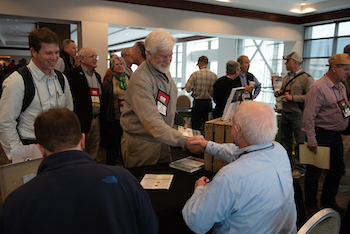
Well, it was really neat to have these people come up to me who I’ve known for years and ask me to write something personal in their copy for them. One of the things we’ve always offered all purchasers, not just at the National No-Tillage Conference, is a personally autographed book. I’d say 40% of the book orders we get, people ask me to write a special note to someone. It’s something I think is important to these people because they are a part of the history of the whole no-till growth movement.
Since From Maverick to Mainstream’s release, you’ve received a lot of sincere comments and feedback from readers — many of which, like you said, you have known for a long time. Are there any specific responses that stand out and have made an impact with you?
Yeah, there have. I mean there are people in the book who have sincerely thanked me for doing this, and it was a pleasure looking back and documenting what happened on these farms. There was one person who bought 26 copies for all of his family members. Another reader bought a copy for each of his landlords he’s renting land from. It’s just a sense of accomplishment for these people so it’s been great to see people pass the book on to others.
No-till was not always looked at as a realistic method of farming. When No-Till Farmer was first started in 1972, did you feel any pushback from those who criticized the method?
Sure! And the first one to criticize was my dad. He asked me, “What are you doing? Are you nuts taking a job involving no-till?” But a few weeks later, he asked me some more questions about no-till and a couple years after that we actually started no-tilling our family farm back in Michigan.
There was a lot of criticism early on. The big farm machinery companies weren’t in favor of no-till. They wanted to keep selling big horsepower tractors and 35, 40-foot wide tillage tools. So, getting where we are today has been a real accomplishment and there’s been a lot of feedback. A lot of the early adaptors would no-till in a field back away from the road so their neighbors wouldn’t see what they were doing, and it grew from there.
Harry Young Jr., whose son wrote the foreword to your book, is considered to be one of the first and most instrumental pioneers of the no-till movement. If you were sitting here today with Harry, reflecting on no-till’s past, present and future, how do you think he would feel about how no-till has risen and evolved?
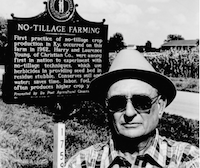
Well, I think Harry would be very proud of the success he had. He started this in the mid ‘60s and it’s really grown from there. In the late '60s, he had tours and 300-400 people would show up on bus tours from a number of states. He hosted tours from South Africa, where there would be 20 or 30 people there. He watched the evolution develop. He saw the benefits of doing this and worked out the details. He can be really proud of what’s happening here today. Today, his son and grandson are still no-tilling the whole farm, the farm where no-tilling began in America, in Western Kentucky.
In From Maverick to Mainstream, you touch on various predictions that may have an effect on no-till in the future. Is there any prediction in particular that you believe will have the most impact on the conservation method or on agriculture as a whole?
Well, we’ve seen no-till acreage really grow from 3.2 million acres in '72, to over a 100 million as we come into 2020. It’s going to continue to grow. We don’t have any more farmland in the United States. We lose farmland all the time, so we’ve got to find ways to increase yields. The farms are getting bigger, and they need new ways to maintain the land using less time and less equipment. With precision farming and technology like GPS, no-till will continue to grow and it’s going to have a major importance in us feeding the world in the future.
Watch the unveiling of the book...


ORDER TODAY FOR $47.95
PLUS, for a limited time only, receive FREE shipping and handling.*
* U.S. Orders Only
For orders outside the U.S. go to No-TillFarmer.com/products/1125 – do not use this online form for locations outside the U.S.
If you are interested in ordering 5 or more copies of the book, please contact Customer Service at (800) 277-1570 or ntf@email.no-tillfarmer.com for information on bulk pricing.
